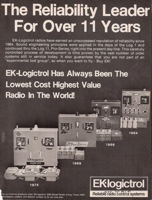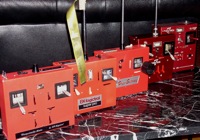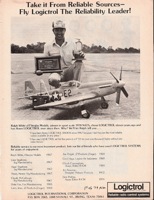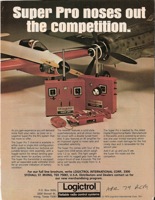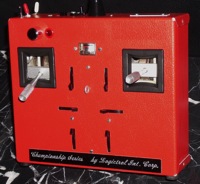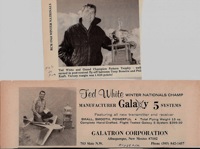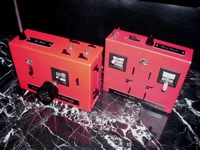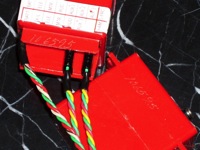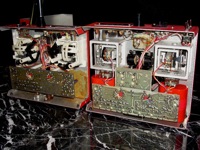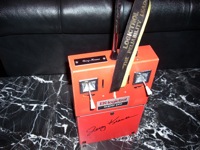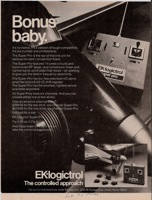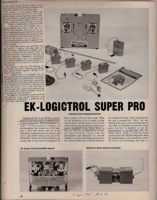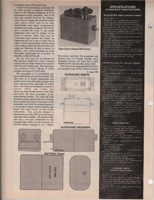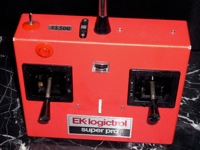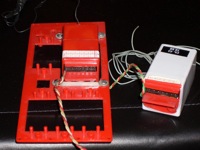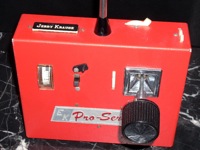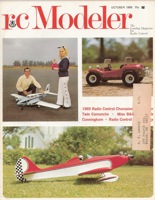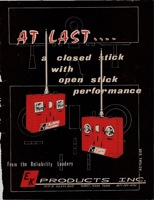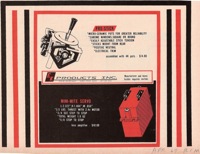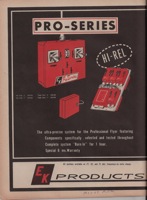Special Exhibit:
Logictrol One
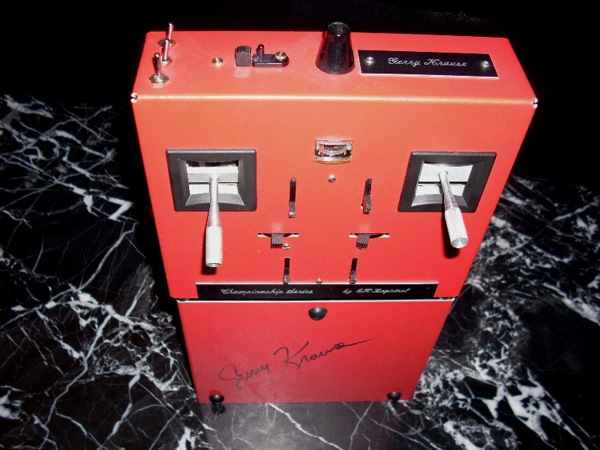
(Click on any of the images on this page to see a larger version)
This was Jerry Krause’s personal Logictrol Championship Series. Jerry founded EK Logictrol in 1964 with Bob Elliot (Elliot and Krause, “EK”). By 1972, Logictrol had grown to such a size that it claimed to make more proportional radios than all other manufacturers combined. Most Logictrols were lower priced systems (see “First Logictrol”), but not all. Logictrol also produced a line of high-end radios. The Championship Series was the highest of the high, and this one belonged to the top guy.
Logictrol One.
Our research into 1970’s era radios has only begun. In particular, we know very little about the Championship Series. As of this writing we don’t even have a single advertisement, product review, schematic, brochure or instruction manual for this enigmatic system. Please feel free to contact us with any information you may have.
Historical Context
Here’s what we “know” so far, some of it surmise. First, the historical context. We believe the Championship Series was the last in the line of Logictrol’s high end radios. Here is Logictrol’s November, 1975 advertisement showing its succession of top quality equipment (Nov 75 Radio Control Modeler magazine or "RCM").
Here is our re-creation of this line-up showing where we believe the Championship Series fits in:
Here is the only advertisement we are aware of picturing a Championship system (Feb 79 RCM):
This appeared in the final months of the company’s existence after its name had been changed to Logictrol International Corp. and its ownership and control may have changed as well. Note that this is merely a generic ad for Logictrol radios; it is not an ad for the Championship Series and does not even identify the system pictured. Here is one of the final Championship Series transmitters. Note the new Company name on the new, mirror-finish plaque. When Logictrol advertised its high-end radios it continued to show the Super Pro, not the Championship Series, as evidenced by this ad run just 7 months before the Company’s advertising fell silent forever (Apr 79 RCM):
The Championship Series was probably introduced some time between 1975 and the end of 1978(best guess, 1976). Most likely, it was an attempt to compete with Kraft’s Signature Series. Like that renowned Kraft system, the Championship Series was custom made with controls positioned where designated by the purchaser, had advanced features, including elevator and aileron dual rates and a roll button, used the smoothest, highest quality open gimbals and came with the owner’s name engraved on it. The engraving process used by Logictrol enabled the owner’s name to reflect light as if illuminated from within.
Rarity
The Championship Series came in both single and dual stick configurations. Here is one of each for comparison. This single stick belonged to Joe Bridi, who was one of the most famous aerobatic and scale competitors, made a line of plans/kits (e.g. Kaos, Dirty Birdy) sought after to this day, and even owned the iconic Pro Line radio control company for a while:
Components
The servos sold with the system may have been the same as Logictrol supplied with its ordinary radios, with one difference. When finished servos arrived from Mexico, they were tested and sorted into three piles depending how close to perfect their performance was. The first pile was very small containing only the very best of all the servos produced. These went with Championship Series sets. Each hand-selected servo and receiver was specially engraved with the serial number of the transmitter it belonged with.
We are uncertain as to the origins of the excellent gimbals. Although resembling Orbit/Dunham sticks as seen on the Orbit Elite and Millcott Specialist radios, they appear to have been made by someone else. From the gimbals to the pots to the circuit boards, there seem to be decisively more and better components in the Championship Series than in its high-end predecessor, the Super Pro. Here are the two side by side with their backs open for comparison:
Super Pro
This was Jerry Kraus’s personal Super Pro—Super Pro One. The Super Pro was Logictrol’s top of the line radio from its debut in 1972 until the company’s demise in 1979. It appears to have been introduced in mid-1972 since Logictrol’s March 1972 Toledo Trade Show display still presented its predecessor, the Pro-Series. Here is the first advertisement we have found for the Super Pro (June 72 RCM):
Here is American Aircraft Modeler’s (AAM’s) 1973 product review for the Super Pro. Note how they state it was little more than a Logictrol Champion with better gimbals:
Here is the September, 1975 RCM review of the Super Pro:
Here is a Super Pro with plastic, open gimbals and two additional control features. This appears to be a prototype for a more advanced Super Pro which was never produced:
One of the most impressive tributes to Logictrol and its top of the line radios is that they were used by so many of the leading scale modelers. The amount of time and money invested by scale flyers in their models vastly exceeds the norm. With so much at stake, the reliability of a radio system is paramount. Logictrol’s ads proudly pointed to how many scale masters chose Logictrol.
UPDATE
Our March 2008 acquisition of a Championship Series Instruction Booklet enables us to reveal some additional information about this special system:
1 It was in fact EK’s ultimate high-end radio – custom made for each purchaser.
2 An additional feature was a tiny Expanded Scale Voltmeter (ESV). This displayed a small voltage drop as a large percentage of the meter face. Flyers were warned that a center scale reading was a full discharge (not 50%).
3 One toggle switch was for retracts. The other two were for dual rates. A roll button was another option. The existence and location of these switches and buttons were evidently entirely custom, as directed by each individual purchaser, as were additional proportional channels.
5 The Instructions warned that these unique, custom-made systems must be “proven by purchaser” despite all the tender loving care (TLC) put into each one by Logictrol. Accordingly, purchasers were warned to do initial flying only in “expendable” airplanes.
6 Here are sample pages from an actual Championship Series Instruction Booklet:
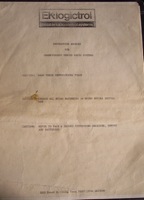 | 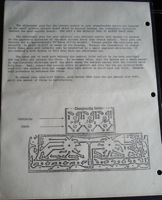 | 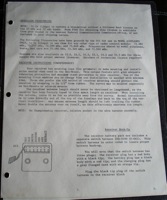 | 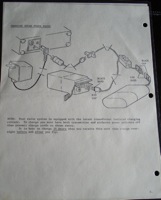 |
Pro-Series
This was Jerry Kraus’s personal Logictrol Pro-Series—Pro-Series One.
The Pro-Series was Logictrol’s first top of the line system. Prior to this, Logictrol produced no budget or sport lines and considered all of its radios to be its top quality.
Here is master modeler Joe Bridi’s Pro-Series featured on the cover of RC M (Oct69) and in full page pictures inside:
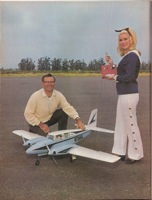 | 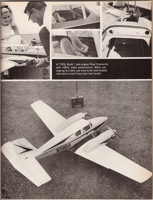 |
The Pro-Series was developed in 1968 and introduced at the March, 1969 Toledo show. RC authority Howard McEntee attended the show and reported that the Pro-Series was similar to other Logictrol systems except that its components were specially selected and it had a longer guaranty (Jun 69 AAM).Here is the first Pro-Series ad we have, claiming to have achieved that elusive goal of all RC manufacturers in the first decade of closed gimbals—open gimbal performance (Apr 69 RCM):
Here is a contemporary ad for that closed-gimbal stick assembly (Apr 69 RCM):
Here is a May 1969 ad essentially agreeing with McEntee’s take—that the major distinction of the Pro-Series was component selection and longer warranty. Presumably, Logictrol technicians sorted ostensibly identical components into different piles depending on how well they performed in tests, and those in the top-performing pile were reserved for the Pro-Series.



